The development of the gubernaculum and inguinal closure in the marsupial Macropus eugenii
- PMID: 12363275
- PMCID: PMC1570914
- DOI: 10.1046/j.1469-7580.2002.00087.x
The development of the gubernaculum and inguinal closure in the marsupial Macropus eugenii
Abstract
This study reports the developmental anatomy of testicular descent and inguinal closure of the tammar wallaby (Macropus eugenii) from birth to maturity. In females the ovary migrated caudally between days 10 and 20 after birth. The gubernaculum differentiates into the round ligament in the abdomen and extra-abdominally as the ilio-marsupialis muscle of the mammary glands. In males the testes migrated to the internal inguinal ring by day 20 post partum (pp), coinciding with the enlargement of the gubernaculum, and from the internal inguinal ring to the scrotum between days 20 and 65 pp. During descent there was an increase in the hyaluronic acid concentration in cells of the gubernaculum and scrotum. Development of the cremaster muscle began by day 10 pp on the periphery of the gubernaculum and its basic structure was completed by day 60 pp. After descent the inguinal canal closed between days 50 and 60 pp, but a small irregular lumen persisted, somewhat similar to that seen in the congenital scrotal hydrocoele of humans. Tammars have a hopping mode of locomotion and, like humans, are essentially bipedal. We suggest that inguinal closure evolved in these two species because their upright posture may otherwise lead to a high incidence of inguinal hernias.
Figures
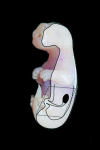
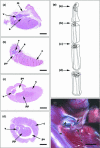
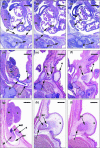
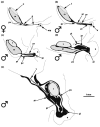
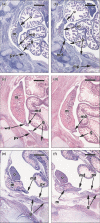
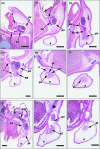
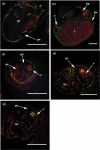
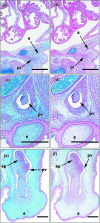
Similar articles
-
Effects of oestrogen treatment on testicular descent, inguinal closure and prostatic development in a male marsupial, Macropus eugenii.Reproduction. 2002 Jul;124(1):73-83. doi: 10.1530/rep.0.1240073. Reproduction. 2002. PMID: 12090921
-
Sexual differentiation of the urogenital system of the fetal and neonatal tammar wallaby, Macropus eugenii.Anat Embryol (Berl). 1996 Aug;194(2):111-34. doi: 10.1007/BF00195006. Anat Embryol (Berl). 1996. PMID: 8827321
-
Effect of an anti-androgen on testicular descent and inguinal closure in a marsupial, the tammar wallaby (Macropus eugenii).Reproduction. 2002 Dec;124(6):865-74. doi: 10.1530/rep.0.1240865. Reproduction. 2002. PMID: 12530924
-
The genitofemoral nerve may link testicular inguinoscrotal descent with congenital inguinal hernia.Aust N Z J Surg. 1996 Sep;66(9):612-7. doi: 10.1111/j.1445-2197.1996.tb00831.x. Aust N Z J Surg. 1996. PMID: 8859162 Review.
-
Cryptorchidism in common eutherian mammals.Reproduction. 2007 Mar;133(3):541-61. doi: 10.1530/REP-06-0272. Reproduction. 2007. PMID: 17379650 Review.
Cited by
-
Comparative Analyses Reveal Conserved and Modified Steps in the Testis Descent and Scrotum Development in Mouse and Opossum.Cells Tissues Organs. 2025;214(3):155-166. doi: 10.1159/000541805. Epub 2024 Oct 4. Cells Tissues Organs. 2025. PMID: 39369713 Free PMC article.
-
Origin of INSL3-mediated testicular descent in therian mammals.Genome Res. 2008 Jun;18(6):974-85. doi: 10.1101/gr.7119108. Epub 2008 May 7. Genome Res. 2008. PMID: 18463305 Free PMC article.
-
Reappraising the exteriorization of the mammalian testes through evolutionary physiology.Commun Integr Biol. 2019 Mar 20;12(1):38-54. doi: 10.1080/19420889.2019.1586047. eCollection 2019. Commun Integr Biol. 2019. PMID: 31143362 Free PMC article. Review.
-
The evolutionary history of testicular externalization and the origin of the scrotum.J Biosci. 2010 Mar;35(1):27-37. doi: 10.1007/s12038-010-0005-7. J Biosci. 2010. PMID: 20413907
-
Regulation of testicular descent.Pediatr Surg Int. 2015 Apr;31(4):317-25. doi: 10.1007/s00383-015-3673-4. Epub 2015 Feb 18. Pediatr Surg Int. 2015. PMID: 25690562 Review.
References
-
- Alberts B, Bray D, Lewis J, Raff M, Roberts K, Watson JD. Molecular Biology of the Cell. 3rd edn. New York: Garland Publishing; 1994.
-
- Archer M, Clayton G. Vertebrate Zoology and Evolution in Australia. Carlisle, Western Australia: Hesperian Press; 1984.
-
- Atwell JD. Inguinal herniae and the testicular feminization syndrome in infancy and childhood. Br. J. Surg. 1961;49:367–371. - PubMed
-
- Atwell JD. Inguinal hernia in female infants and children. Br. J. Surg. 1962;50:294–297. - PubMed
Publication types
MeSH terms
Substances
LinkOut - more resources
Full Text Sources
Miscellaneous

